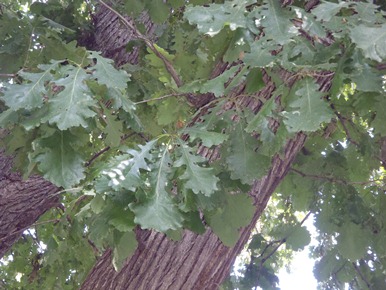Now that it is October, we can start thinking about Halloween. One time-honored tradition of Halloween is to watch scary movies. The thing I always remember, as a Horticulturist, is the scary looking trees in those Halloween movies, typically bur oaks.
Bur oak, Quercus macrocarpa, is a white oak and it grows up to 85 feet tall and wide. Oak trees are divided into two main groups, red oaks or white oaks. White oaks have no bristle on the tips of the rounded lobes of the leaves, the fruit matures in one season, and the nut is sweet. Red oaks mostly have bristle-tipped pointed lobes of the leaves, the fruit matures in two seasons, and the nut is bitter.
Bur oak is native to Nebraska and has typical oak leaves with 2 to 7 lobe pairs on the leaf. The leaves are dark green and shiny on the top side and fuzzy on the bottom side. The leaves turn a beautiful yellow-brown color in the fall. The acorns on bur oak only stick out about half way from underneath a deeply fringed involucre, which is the hood-like covering on the top of the acorn.
Bur oak is a tough tree and because it is a native, it does very well in our environment. It will tolerate city conditions and poor soils, stressful conditions for many plants. You'll find this tree in almost any type of environment including along streams, in prairies, and city landscaping areas. Bur oak, like most oaks, grows slowly. The slow growth allows it to develop a stronger trunk and branches, helping it to withstand strong winds and storms where other, faster growing trees would not. Bur oaks are great for the landscape in naturalized or forested areas as well as for providing shade in a yard. Bur oaks are susceptible to oak wilt and, therefore, should not be pruned in the months of April, May, or June to avoid spreading this disease.
Many uses and values are associated with bur oak trees. Wildlife, especially deer, squirrels, and birds, relish the acorns, and also may feed on the leaves. The wood is used to make furniture, flooring, watertight barrels, and more. According to the Missouri Department of Conservation, the explorers Lewis and Clark met with a group of Native Americans under a specific bur oak tree. The tree had to be cut down in the 1970s and was replaced to mark this historical site. According to the USDA, Native Americans used the bark to make an astringent to treat wounds, sores, diarrhea, insect bites, and poison oak. The acorns also have been eaten boiled or raw, but may cause an upset stomach.
Bur oak is a great tree to use on your acreage or in a landscape setting. This native tree will survive in most any environmental condition, just be careful when timing your pruning to not spread Oak Wilt. If you need a great shade tree or windbreak tree for your acreage, look to the Bur Oak. Just be patient.

